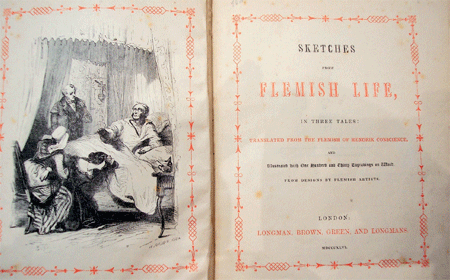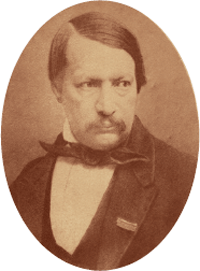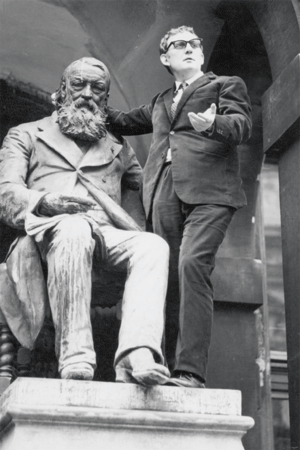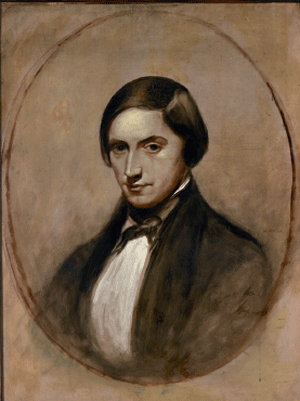|
| |
| |
| |
The Highs and Lows of Hendrik Conscience
[Theo Hermans]
The case of the Flemish author Hendrik Conscience (1812-1883) is unique. Having set himself up as a professional writer at a time when Flanders had no publishing industry to speak of, he went on to produce a hundred novels and novellas to immense success. Translations into German, French, English and other languages made him a European celebrity almost overnight. No author writing in Dutch, past or present, has been translated on such a scale and with such intensity. A statue in his honour was erected during his lifetime. Upon his death he was awarded a state funeral with full military honours; tens of thousands lined the streets to pay their respects.
His fame did not last. Translations into foreign languages petered out within years of his passing. Very few if any of his works are currently in print. His masterpiece, The Lion of Flanders (De Leeuw van Vlaenderen, 1838), the iconic Flemish novel of the nineteenth century, remains unread today and is widely regarded as unreadable. What happened? What went wrong? What's left?
Hendrik Conscience grew up with two languages and never felt entirely at home in either. Born in Antwerp to a French father and an illiterate mother, he began by writing in French. However, in those heady romantic days he would not be bound to a single tongue. A short satirical play from 1836, ‘Lucifer, or Satan Converted’, which mercifully remained unprinted, had Lucifer reading an edict from God that consisted of ‘words scrambled from eight languages’:
Loïti faquïen tolanchä Consay
Oquïendo Quichen tatès Satanas,
figènoiïama Chimantès, Suntïen
Cum érodal; paguïa olam canchïa
Chèquëam Mocaïjoij: Coquinez
faxibol, Jehova, BungoCooij
Comboodoässi, outénobista!?
The initial sketches of his first novel, In the Year of Wonder (In 't Wonderjaer, 1837), were in French, but then he made a conscious decision to continue in Dutch. In a letter from October 1838 he described a scene from his new work,
| |
| |
 The Lion of Flanders
The Lion of Flanders, still switching from one language to the other: ‘in the evening Breydel and his friend De Coninck are sitting in a tent, ils mangent des betteraves cuites sous la cendre et boivent du vin...’. In later years he taught himself German and some English, and occasionally translated from German into Dutch.
He also engaged in translation of a very different kind, transforming himself from the defiant romantic of his youthful years into a pillar of Belgian society, and of its Catholic establishment in particular. Both In the Year of Wonder and The Lion of Flanders appeared in amended editions in 1843. In the case of the Lion of Flanders the revisions did not amount to much more than toning down the rough or excessively passionate language of individual characters. In the Year of Wonder, its title now shortened to The Year of Wonder, became a different book altogether, with a different ending. The freedom-loving Protestant rebels of the first edition were now portrayed as a lawless bunch of anti-Catholic fanatics. A friar who had a minor part before was made into a central character, so that the book as a whole clearly supported the preservation of the Catholic faith. The fiery authorial introductions championing the Flemish cause which adorned the first editions of both novels were quietly omitted.
Conscience's conversion to Catholic conformism was a feather in the cap of J.B. van Hemel, director of the main seminary in Flanders and a powerful man in this predominantly Catholic region. Among other things, he sat on the commission that decided on books to purchase for the nation's schools, hospitals
| |
| |

Hendrik Conscience ca. 1845. Letterenhuis, Antwerp
and prisons. In a suave letter full of veiled threats Van Hemel insisted on the necessary changes in return for bulk orders. His demands answered the political circumstances of the period. In the early 1840s, following ten years of unionist governments, the Catholic and liberal camps that together had achieved Belgium's independence in 1830 were drifting apart and consolidating into sharply antagonistic parties. Van Hemel was merely strengthening his own side.
For Conscience, the money mattered, too. He had to pay for his early books to be printed. His debut novel In the Year of Wonder had cost him the equivalent of a year's salary. Even though The Lion of Flanders proved a runaway success, it had been expensive to produce and made only a modest financial profit. As Conscience pointed out to his publisher many years later: if he wanted to live off his pen, he needed to sell books.
In meeting Van Hemel's ideological demands Conscience may have compromised his artistic integrity, but his talent for storytelling remained undiminished. Longer and shorter narratives rolled from the presses. He continued to write historical novels but branched out into edifying village and small-town tales. In 1846 he signed a fixed-term contract with a publisher, and similar contracts followed in subsequent years. Henceforth he would be paid by the page and could tailor his narratives to a desired length. He was now a professional writer.
| |
Numerous translations
He was also well on his way to becoming an international celebrity, in numerous translations. The first few translations of Conscience's work appeared in Francophone Belgian newspapers and magazines, but they had little effect. The breakthrough came in Germany in 1845, when Melchior von Diepenbrock, the newly appointed Bishop of Breslau (today Wrocł aw), brought out a collection of three of Conscience's stories in German translation. He had come across them by accident. The little book sold 14,000 copies in two years and was in turn translated into English, Italian and Czech.
Things moved rapidly from then on, especially in Germany. The year 1846 was remarkable, as publishers rushed to issue their versions of Conscience's work. Aschendorff in Münster produced three novels - The Year of Wonder, The Lion of Flanders and Conscience's third novel, Hugo van Craenhove - and two collections of stories, one of these containing the same stories Von Diepenbrock had translated a year earlier, but now in a different version. In Stuttgart, Franckh published two novels, The Year of Wonder and Hugo van Craenhove, in their own translation. The Year of Wonder was brought out by another Stuttgart publisher, Hallberg, in a third German version. In Bonn, A. Marcus came with three titles: Hugo van Craenhove in yet another translation, another version of The Lion of Flanders, and a collection of stories which largely but not wholly overlapped with that issued by Aschendorff in Münster. A fourth version of Hugo van Craenhove saw the light in Leipzig with C.B. Lorck, and Overmann in Cologne produced a fifth translation, just when the publisher Pustet in Regensburg printed its own version (the fourth translation) of The Year of Wonder. The total for 1846 adds up to fourteen titles in translation, in more than twenty volumes printed for seven different publishers in six German cities.
| |
| |
When Conscience's novel The Poor Gentleman (De arme edelman) appeared in 1851, three publishers in Leipzig and one in Düsseldorf each presented their own versions to the public within a year. Two years later Aschendorff brought out a fifth version that was reprinted four times in its first ten years and continued to be reissued about once every decade until after the First World War. In the meantime Reclam, another Leipzig publisher, came with yet another version, the sixth, which was reprinted roughly every five years from 1877 till 1920. To close the series the Westphalian publisher Hamm produced a seventh translation in 1900. A bibliographical inventory of German renderings of Conscience's works runs to 449 entries in book form; the number of translations in periodicals is unknown. In 1942 the publisher Aschendorff calculated that their own translations of Conscience had, over the years, sold around 400,000 copies.
Some of these German translations appeared in series of world literature, but before long many began to slip from reading matter for adults to collections

Hendrik Conscience meets Hugo Claus in 1965
© Roland Minnaert
| |
| |

Hendrik Conscience ca. 1830. Painting by Xavier de Cock. Letterenhuis, Antwerpen
aimed at adolescents. The English translations show a similar pattern. Whereas Conscience's early work found a place in series like Constable's Miscellany of Foreign Literature or, for the shorter pieces, Half-Hours with Foreign Authors, many of the later translations appeared in The Amusing Library, Dunigan's Home Library, Duffy's Popular Library and other such lowbrow series. Veva, or the War of the Peasants ( De boerenkryg, 1853), a novel set in the aftermath of the French Revolution and translated into English not from the original Dutch but after a French version, was cut up into episodes apparently designed to serve as ‘railway literature’, the new lightweight genre that catered for those travelling by train. The downward slide from high literature into popular reading is unmistakable.
It will not have troubled Conscience unduly. In January 1854 he signed a contract with the Paris publisher Michel Lévy stipulating that everything he had written so far and everything he was still to write would be translated into French. Lévy consequently published Conscience's collected work in French translation in sixty volumes, with another edition after the author's death in eleven volumes. For their part, Aschendorff in Münster brought out a German collected edition in seventy-five volumes. English translations were not quite so spectacular, but even here we encounter editions in up to ten and twelve volumes. Between 1854 and 1889 the story Blind Rosa was printed at least eight times in English translation, Wooden Clara ten times, The Village Innkeeper (Baes Gansendonck, 1850) eleven times, The Conscript (De loteling, 1850, also translated as The Recruit) twelve times, The Poor Gentleman fourteen times. Most of the English translations appeared without the name of a translator.
| |
Plagiarised but not paid
The author assisted his translators when he could, carefully fashioning his self-image in his correspondence with them, enabling some of them to translate from the proofs instead of having to wait for the printed book, and authorising them to make changes in the texts to suit the taste of the intended audi- | |
| |
ence. But there was much that remained beyond his control. The most searing episode involved none other than Alexandre Dumas, who plagiarised a French version of the novella The Conscript and expanded it into a three-decker novel. Dumas reckoned he had paid homage to Conscience by stealing from him (‘je lui faisais bien de l'honneur en le volant...’). Two novels, one called The Miser and the other The Village Innkeeper, appeared in London in 1868 and 1871 respectively, both signed by one Hope Inslow (almost certainly a pseudonym) as the author, both plagiarised from Conscience.
In the nineteenth century the legal framework governing intellectual property was still under construction, and this explains the contrast between the proliferation of German translations and the exclusive contract with Michel Lévy's company in France. International copyright law did not yet exist, only bilateral treaties. In the absence of copyright agreements between Belgium and the German states, German publishers could publish whatever translations they pleased. As a result, we know the names of over forty German translators of Conscience, and many other translations appeared anonymously. Following the copyright agreement signed between Belgium and France in 1852 and the contract with Lévy in 1854, Conscience had just two translators into French, first Léon Wocquier and then, from 1860 onwards, Félix Coveliers. Every title issued by Lévy featured a dire warning to the effect that any infringement of intellectual property would lead to prosecution. The copyright agreement concluded between Britain and Belgium in 1855 protected English translations published in the British Isles but not those in the USA.
For all the personal satisfaction that Conscience may have derived from seeing his work blossom in such a stupendous number of foreign translations, they brought him little financial reward. Lévy paid only intermittently, and Conscience had to chase him and beg for his money constantly. The many hundreds of English, German and other translations afforded the author not a penny.
| |
Talent for storytelling
Although Conscience, always hungry for recognition, relished his status as an international celebrity, that status proved short-lived. The popularity of his work brought him a large but not necessarily a very discerning readership. As book production steadily increased and literary fashions moved on towards the end of the nineteenth century, the downward slide in his standing as a writer proved fatal. As early as 1855 George Eliot had put the knife in. Both as a critic and as a novelist she championed realism in fiction and objected to sentimentalism, moralising and idealisation. Writing in the Westminster Review about the five volumes of Conscience's Tales and Romances brought out by the London publisher Lambert & Co., she showed herself aware of ‘the high praise bestowed on these fictions in many quarters’ and conceded that the books were ‘in demand among a large class of persons.’ But her own reading experience did not match her expectations. She confessed to being ‘utterly disappointed,’ finding the stories tendentious and lacking in both plausible characters and natural dialogue.
From our contemporary vantage point Eliot's criticism seems entirely justified. But we need to remember the angle from which Eliot was writing. Of course, the poetics she was promoting had the future. The novel was developing towards
| |
| |
greater realism, a focus on psychologically complex characters, and aesthetic rather than didactic concerns. Subsequent modernist experiments would only radicalise these trends. They left Conscience looking outmoded and simplistic.
Nevertheless, it is worth asking what made Conscience appeal to such a large class of people, not just in his native Belgium but in other countries and languages as well, for half a century. The answer is likely to be found in his singular talent for storytelling. He was no linguistic virtuoso, his narratives are sentimental, his plots unreal and their moral judgements conservative to the point of being reactionary, but he knew how to draw the reader into a fictional world.
The brief evocations of nature which often introduce new scenes hold the reader's attention. Several stories employ frame narratives presenting a first-person narrator who directly addresses the reader so as to suggest both familiarity and distance. The changes of pace which punctuate the rhythm of the narratives make the reader aware of how expectations are built up and manipulated. The descriptions of mass scenes are epic in scale.
| |
Interrogate these stories again
However, the sheer fluency with which these narratives unfold also invites us to read them against the grain, for the paths not chosen as much as for what is there. To take a single example: in The Village Innkeeper (Baes Gansendonck) the protagonist, a haughty man, causes his daughter irremediable heartbreak by thwarting the love affair between her and the local brewer's son because he prefers to see her married to a parvenu from the city. The story ends tragically: the girl pines away and dies, the boy goes mad. We may wonder why the girl never blames her father for destroying her life and why the boy, too, while still compos mentis, forgives him but seems intent on cutting the parvenu's throat. We may also wonder about the ending itself: surely the innkeeper could have been shown to find humility without the tragic denouement running its full course? What is it in the ideology sustaining the story that dictates such a brutal fate?
The contrast between Conscience's huge success for a good part of the nineteenth century and the oblivion that has befallen him in more recent decades is so stark it must raise questions about why and how he was read then and how he can and perhaps should be read now. No doubt he is to be read only selectively, as indeed most writers are. But we owe it to generations of international readers to interrogate these stories again, from every possible angle.
| |
Further reading
| Arents, Prosper. De Vlaamsche schrijvers in het Duitsch vertaald. Brussel 1944. |
| Arents, Prosper. De Vlaamse schrijvers in het Engels vertaald 1481-1949. Gent 1950. |
| Hermans, Theo. ‘“Tusschen Europeaensche vermaerdheden.” Het vertalen van Hendrik Conscience.’ Filter 18, 2011 (3), 27-34. |
| Keersmaekers, August. Hendrik Conscience. De muze en de mammon. Gent 2009. |
| Simon, Irène. ‘George Eliot and Hendrik Conscience’, Revue des langues vivantes 26, 1960, 386-89. |
| Wellens, Oscar. ‘De kritische receptie van Conscience in Engeland’, Handelingen Koninklijke Zuidnederlandse Maatschappij voor Taal- en Letterkunde en Geschiedenis 36, 1982, 259-71. |
|
|